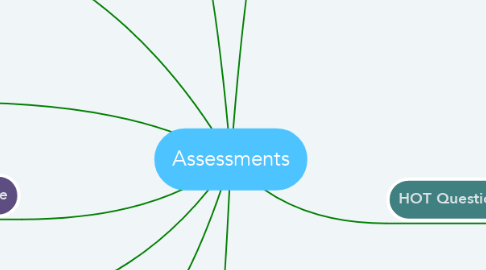
1. Summative
1.1. Assessments that are high stakes and are used to evaluate student learning, usually at the end of a unit.
1.1.1. Unit Assessment
1.1.2. STAAR Test
2. Formative
2.1. Assessments that allow teachers to monitor their teaching and students to monitor their learning. They are low stakes and should be used throughout teaching.
2.1.1. Quick Write
2.1.2. Exit Ticket
3. Interim/Benchmark
3.1. Assessments that are based on a standard, or benchmark, that allow student scores to be seen compared to an average.
3.1.1. MAP
3.1.2. Mid-year assessment
4. Performance
4.1. Assessments used to apply students' knowledge gained to a final assessment.
4.1.1. Project
4.1.2. Presentation
5. Diagnostic
5.1. Also known as pre-assessments, these help to assess students prior knowledge of a topic or student misconceptions.
5.1.1. MAP Testing
5.1.2. Mini Papers
6. Assessments can be used to help teachers check for understanding, adjust instruction, know where to begin their teaching, prior knowledge, and if students need intervention or re-teaching.
7. Students benefit from assessments by monitoring their own learning, representing their mastery of content, being creative, and showing their knowledge.
8. HOT Questions
8.1. Opening Questions
8.1.1. If I move the placement of the parenthesis, does this change my answer? Why?
8.1.2. Explain why I have to build my array first before I add?
8.2. Guiding Questions
8.2.1. What would you do to this equation to change the answer?
8.2.2. Why is it important for us to understand how to do order of operations?
8.3. Closing Questions
8.3.1. Describe how you solved your equation.
8.3.2. Write your own equation and solve. Explain your process.
9. Assessment Data
9.1. Teachers can use data to help assess student learning or understanding and adjust accordingly using different strategies.
9.1.1. 3 Struggling Students pulled for RTI in Prime and Composite numbers and Order of operations: Student 1: 40% Student 2: 30% Student 3: 50% Strategies for intervention: Students will be pulled to teacher table to work on factor trees, order of operations matching cards, using highlighters for order of operations, order of operations card game, individual practice, pulled back to teacher table for reteach of operations.
